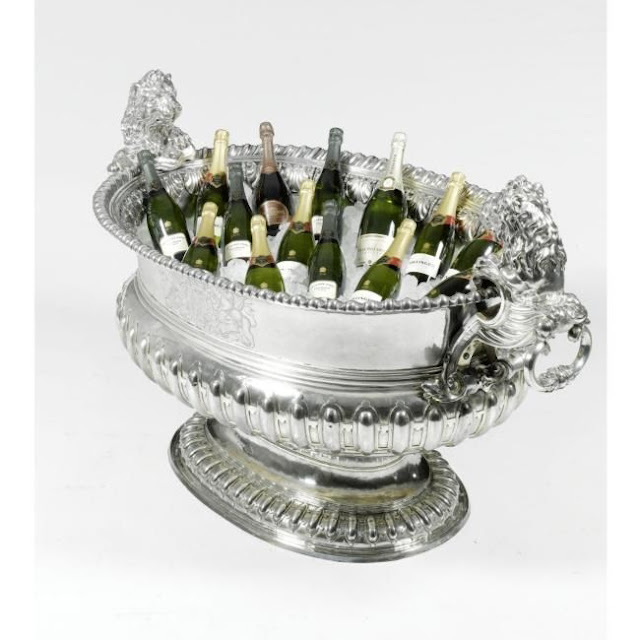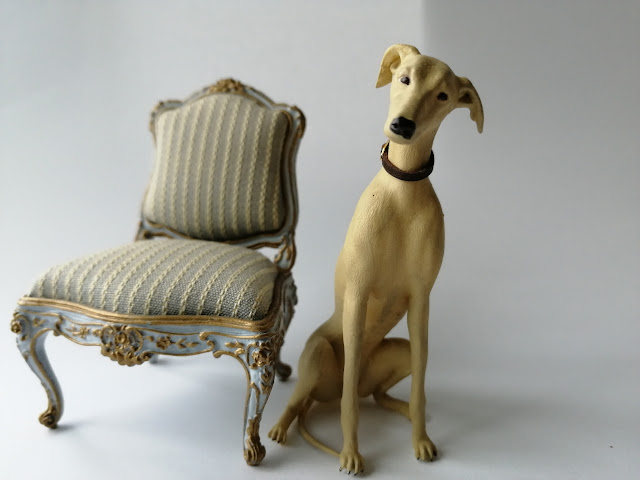Hello my friends,
While packing, and (months later) unpacking and inventorising all the mini's that I have collected the last years I've come across some miniatures that I actualy had forgotten all about. How unlikely this may seem. It is true.
Often when I take a miniature back home or receive it in the post, I make pictures of it and put it in a box to keep it safe until I can place it in a room. It is no secret to you my friends, that I do not yet have a single room of Huis ter Swinnendael that is finished. I must make that a priority for 2022!
Sometimes I have forgotten to take pictures or RL had to come first, or whatever you can think of... Which has sometimes resulted in me forgetting that I have bought a certain miniature at all!
What have I forgotten(and forgotten to show you)? Well, these for examble. A set of four silver salt cellars that I bought back in 2016. These salt cellars are pre-1918 Russian silver. But do not get too excited. They predate the revolution by only 9 years. And the maker is certainly no Faberge or the likes of him. It is not even hand made but machine pressed into a mould.
And, despite their decorative Rococo appearance, these are made of third grade (80%) silver. With the first graden for continental silver being equal to sterling (92.5%) silver. In Europe/the world, 'third grade' is the lowest grade allowed where we still may speak of silver. If the amount of silver in the alloy falls below that percentage it is often called 'white metal' because you can no longer speak of silver.
So it is safe to say that these small salt cellars, from a set of four, will not have graced a noble or imperial table. But they look good do they not? I certainly think so.
I love silver. Espescially on my dinner table. And I have some nice (family) pieces to put on the table, but I bought these with Huis ter Swinnendael in mind. Wine cisterns are a type of wine cooler that was popular from the renaisance imto the 19th century. Marble was an often used material, but there were and are also silver examples. And even golden or gilt ones! But those are extremely rare.
These cisterns are much larger than our common wine coolers. They could hold all the bottles cool that would be needed for the party (and more) , unlike the winecoolers we use that are generally suited for one bottle at a time.
If you look at the first picture of real antique wine cisterns above, you can see that these are (very, very) big pieces of silver. The second picture you may recognise as a part view from the 'Kamer met rood Moor' from one of the 18th century Cabinet Houses of Sarah Rothe van Amstel (which now stands in the Frans Hals museum in Haarlem) there we see a miniature wine cistern in the middle of the bottom shelf.
Now looking back at these salt cellars, which are not thát big, compared to some of the other salt cellars that we use at home when having dinner parties. But with a diameter of 4 cm/ 1,58 inch across these constitute miniature versions of wine cisterns of almost 50 cm/ 19 inch in reality. And that comes very close to the cisterns shown above.
The diningroom in Huis ter Swinnendael will have not one but two wine cisterns to cool the wines and spirits served during dinner parties and danses. A bit too grand for the Zonneschut family perhaps but (at least one) it would be within their reach. So why not?
Two lovely candlestands, or gueridons/ torcheres as I like to use the french/dutch term for them, made by John J. Hodgson. These were bought back in 2019. I have shown you the side chair and the large rococo mirror before, but not these two.
These are not gilt but painted with details in gold paint. I love them very much. They are so elegant! Unfortunately the prices most of his excuisite miniatures are out of my reach. But now and then I can splash out on a special item.
A stash of pottery bij Elisabeth Causeret bought back in 2020. You have seen her work on my blog before. I have shown you my purchases of her work in Armhem over the years as yoou can see in the picture above. but you have not seen my bulk buy at the start of the pandemic.
I heard from a good friend (who usuallly is well informed) that Elisabeth would stop that year. I panicked a bit, because there was still so much pottery that I planned on buying in the years to come that had not been acquired yet. So without verifying the rumour I placed two large orders via email.
And when I received them I was told by my good friend that her 'source' had mixed up her name with that of another miniaturist that actualy was retireing from the miniature shows. So I had acted too hastily. But even better, Elisabeth did nót retire and still makes her wonderful ceramics and stoneware it all of us to enjoy! And even better still, she has used the 'interlude' due to the pandemic to create new models and glazes. So my bulk order was unnescessary and premature. But that does not change the fact that I am very happy to have all these great miniatures.
And then there were these little green goblets. These are made by Thai Glasscraft. I found them on Etsy. Although they are a tad bigger than the roemers and flute glasses that are made by Gerdt Felka (as you can see in the top picture), These different shapes are good reproductions of 17th century glasses. They will find a way into the kitchens some day.
So, these were my lost treasures. You may not believe it but I really had forgotten all about them untill I opened their boxes! Isn't that just silly? But more importantly I found them again.
Well that is all for now. Stay safe.
Huibrecht












































